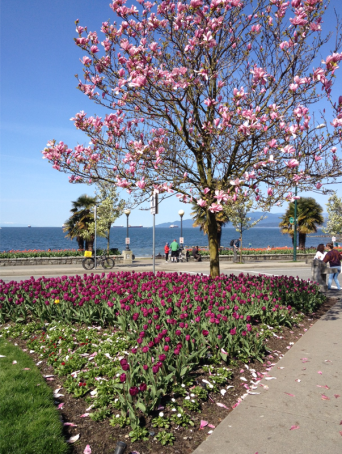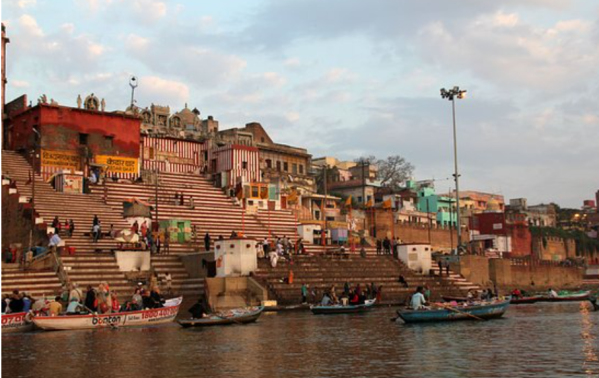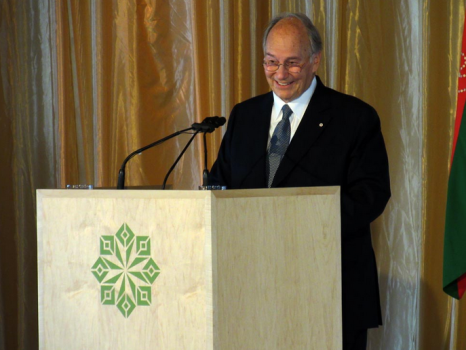An Interpretation of the Ghat Paat Ceremony
Even though we may be surrounded by negativity, we can individually create a positive attitude albeit momentarily. Hence we are constantly reminded to call upon the Name to enhance positive outlook.KayBur wrote:The positive impact on water is extremely problematic because each of us is surrounded by negativity. Someone himself is overwhelmed with negativity, someone is saturated with negativity from others.
That is the reason for reciting prayers over Abe Safa and the Ginans during the Ghat Paat ceremony to remind us of our values and create a positive environment. According to our tradition, spirits and angels are present during the Ghat Paat ceremony to help us in this regard.
Anecdote below from Mumtaz Tajdin's 225 Anecdotes at: http://ismaili.net/source/books/225anecdotes.pdf , alludes to the power of holy/blessed water to heal physical health issues.
*(23) Mawlana Hazar Imam for the first time visited Tajikistan between 22nd May, 1995 and 29th May, 1995 to grace didar to the Ismailis. The fourth and the last didar was at Ruhshan on 27th May, 1995 at about 10.00 am, where the Ismailis had swarmed like locusts at about 6.00 am. On the other hand, the Imam’s car started at 9.00 am. On his route, there appeared a square junction, where the Imam stopped car. There were a gas station, a coffee-house and a handicraft store. The Imam entered the shop of the handicraft and watched the displayed items minutely. The Imam took a small bowl, wherein Sura Fatiha was engraved. The Imam asked its price at the counter, he was told ten dollars. The Imam asked his Secretary to give him twenty dollars and then put the bowl in his coat’s pocket. Then they reached the destination, where was a small hill. The Imam saw some smoke on the hill. Being asked, the Imam was informed that on the hilltop resided the Ismailis, all of them have come down for the didar except the senior persons. The Imam looked at his watch when it was 9.45 am. The Imam said, “First we go on the hill.” The Imam’s car slowly ascended through the coarse and zigzag track and reached. There about 80 old persons saw the Imam coming out of the car, they sat down wherever were stood and prostrated with folding hands. The Imam told them to make a row and granted them didar. The Ismailis were happy with tears streamed in their eyes. Upon the departure, the Imam asked, “Is there any problem?” All of them were silent. The Imam repeated, hence one old lady took a lead and came forward and said, “Mawla! The engineers of the Russian Mineralogical Department discovered that there is much gravity of the magnetic loadstone beneath our hill. It is causing miscarriage cases of the pregnant women.”*
*Then, the Imam took out from his pocket that bowl contained Sura Fatiha and gave her and said, “You put water into the bowl and recite Nad’e Ali, then give it to the pregnant woman to drink. Insha-Allah, I hope her problem will be shunned.” Before sitting inside the car, the Imam said, “You infuse in mind that when the Aga Khan Health Board will open here the Maternity Home in future, then this bowl will be inactive.”*
*(23) Mawlana Hazar Imam for the first time visited Tajikistan between 22nd May, 1995 and 29th May, 1995 to grace didar to the Ismailis. The fourth and the last didar was at Ruhshan on 27th May, 1995 at about 10.00 am, where the Ismailis had swarmed like locusts at about 6.00 am. On the other hand, the Imam’s car started at 9.00 am. On his route, there appeared a square junction, where the Imam stopped car. There were a gas station, a coffee-house and a handicraft store. The Imam entered the shop of the handicraft and watched the displayed items minutely. The Imam took a small bowl, wherein Sura Fatiha was engraved. The Imam asked its price at the counter, he was told ten dollars. The Imam asked his Secretary to give him twenty dollars and then put the bowl in his coat’s pocket. Then they reached the destination, where was a small hill. The Imam saw some smoke on the hill. Being asked, the Imam was informed that on the hilltop resided the Ismailis, all of them have come down for the didar except the senior persons. The Imam looked at his watch when it was 9.45 am. The Imam said, “First we go on the hill.” The Imam’s car slowly ascended through the coarse and zigzag track and reached. There about 80 old persons saw the Imam coming out of the car, they sat down wherever were stood and prostrated with folding hands. The Imam told them to make a row and granted them didar. The Ismailis were happy with tears streamed in their eyes. Upon the departure, the Imam asked, “Is there any problem?” All of them were silent. The Imam repeated, hence one old lady took a lead and came forward and said, “Mawla! The engineers of the Russian Mineralogical Department discovered that there is much gravity of the magnetic loadstone beneath our hill. It is causing miscarriage cases of the pregnant women.”*
*Then, the Imam took out from his pocket that bowl contained Sura Fatiha and gave her and said, “You put water into the bowl and recite Nad’e Ali, then give it to the pregnant woman to drink. Insha-Allah, I hope her problem will be shunned.” Before sitting inside the car, the Imam said, “You infuse in mind that when the Aga Khan Health Board will open here the Maternity Home in future, then this bowl will be inactive.”*
An anecdote from the life of a prominent Sufi Daqqaq-Qushayri alludes to the power of blessed water to heal physical diseases.
The remarkable relationship that Qushayri had with his sons is confirmed by an episode quoted by Subki. One of his sons fell seriously ill and was about to die. The pain that this possibility awoke in Qushayri prompted a vision of God in a dream where he told him to take all the healing verses of the Qur’an ( ayatal-shifa ) and to recite them over the boy, then to write them on a glass, fill it with a drink and to let the boy drink from it. The son subsequently recovered.
https://www.academia.edu/5836461/_The_S ... card=title
The remarkable relationship that Qushayri had with his sons is confirmed by an episode quoted by Subki. One of his sons fell seriously ill and was about to die. The pain that this possibility awoke in Qushayri prompted a vision of God in a dream where he told him to take all the healing verses of the Qur’an ( ayatal-shifa ) and to recite them over the boy, then to write them on a glass, fill it with a drink and to let the boy drink from it. The son subsequently recovered.
https://www.academia.edu/5836461/_The_S ... card=title
Ritual of ghat-paat is a conscious effort to reach spiritual awakening
BY NIMIRA DEWJI POSTED ON NOVEMBER 4, 2021
Their Lord will give to them to drink a pure drink (76:21)
In the Quran, nature and water are explained as signs of God (ayah), which is also the term used for each verse of the sacred text. “That means that, like the words of God written as verses in the sacred text, nature and water specifically are signs of God on which people are called to meditate. Hence, nature is a scripture that surrounds us, which we must learn to read and interpret, just as we read and interpret explicit scriptures that God has revealed” (Asani, The Chautauquan Daily).

Water is a gift from God Who wills it to fall:
“And We send down from the sky blessed water whereby
We give growth unto gardens and the grain of crops” (50:9).
The Islamic tradition teaches that life originated from water:
“We have made all living things by means of water” (21:30).
Hence water predates Creation. In the Quran, it is written:
“And He it is Who created the heavens and the earth in six days,
and His throne was upon the water” (11:7).
Cleansing rituals are performed before entering into a state of prayer. Asani states “the idea is that you’re symbolically cleaning your body from the outside before you enter prayer to purify it from the inside… the purity of water metaphorically reinforces the purity of prayer.”
Water plays an important role in the writings of mystical Islamic poets. Raindrops falling to Earth and “immersing themselves in the vast waters only to be drawn back up to the sky, captivated mystic poets, because they saw how this journey reflected the journey of the human soul. In popular tradition, a raindrop was thought to eventually return to the ocean or turn into a pearl. That describes a soul that must leave God, mature in the world, and then return to its place with God” (Asani, The Chautauquan Daily).
The vastness of the ocean was often used as a metaphor for vast knowledge, both divine and human. One might swim in it, enjoy a beautiful view of it, none can hope to fully master it.

Water in Islam emphasises the unity of all God’s creations. All living things, though diverse, are connected through water. “Fundamentally, water represents limitless knowledge of God” (Asani).
Many religious traditions use consecrated water in their rituals, which are outer expressions to inner beliefs, re-affirming their relationship to the divine. Prophet Muhammad used water to heal spiritual and physical ailments. Believers would also ask the Prophet to dip his hand into a bowl of water, which they used for healing. Muslims believe the well of zam zam has healing power. Several Twelver Shi’i, “dissolve the dust of Karbala (khak-i shifa), where Imam Husayn is buried, or that of Najaf, the resting place of Imam Ali, and drink the resulting healing water (ab-i shifa) as a cure for illness, both spiritual and physical” (Virani, The Ismailis in the Middle Ages p 107).
In the esoteric Ismaili tradition, the consecrated water is partaken in the ghat-paat ceremony, whereby vessels are placed on a long, low table, the paat. The term ghat, from the Indic tradition, refers to a series of long steps leading to a body of holy water such as the ghats of Benares (Varanasi) descending into the Ganges, the most sacred river in Hindu tradition (Ivanow, Fifty Years in the East p 154 n.62).

Dashashwamedh Ghat, Varanasi. Image: Tripadvisor
Benares is one of the most sacred sites for Hindu pilgrims, who dip into the Ganges for spiritual cleansing. The Ganges is understood as the personification of the deity Ganga, and according to Hindu legend, those who are cremated in Varanasi will achieve enlightenment and be free of the cycle of death and re-birth. Each of the eight-four ghats is associated with a specific legend. The spiritual name for Benaras is Kashi, from the Sanskrit prakash, meaning ‘light’ or ‘shining city’ (Anika Gupta, Smithsonian Magazine).
The ritual of ghat-paat was introduced by the da’is sent to the subcontinent perhaps as early as the Fatimid period (909-1171). Nanji states a possible root of this tradition is the Hindu custom of soma, “which in the Vedas denoted the juice of a plant which, extracted and fermented, forms a beverage offered in libations to the deities and drunk by priests” (The Nizar Isma’ili Tradition p 175 n.21). The divine drink is also called amrta, which occurs in the garbis in relation to the drinking of the sacred water [blessed by the Imam of the time].
Virani notes that Fidai Khurasani alluded “to the distribution of healing water by the Imam Islamshah [r. ca. 1370-1425], “a tradition that is frequently referenced in the ginans. The sacred water is also termed paaval signifying ‘that which purifies.’ This ritual is similar to Sufi tradition pyala lena, ‘to take a cup’ (The Ismaili in the Middle Ages p107).

Ab-e-Shafa set. Image: The.Ismaili
The ritual prayer of ghat-paat is found in the oldest Khojki manuscripts, but a form of the ceremony survives even among the Imam Shahi groups, who also share ginans with the Khoja Ismailis.
Pir Shams composed a garbi in which he explains:
Gur kadhiche paval haathe, amijal bhariya re
Pir has prepared Ab-i shafa with his own hands
Pave sahu sahune melvi sathe Pire maher dhariya re
Pir, with his mercy, is making everyone partake of it.
(tr. M Kamaluddin, Ginan Central, University of Saskatchewan)
Listen https://ginans.usask.ca/recitals/503030
In esoteric traditions including the Ismaili Tariqah, both the outer (zahiri) and inner (batini) are essential in the practice of the faith, although emphasis is placed on the batini aspect of the ritual. Water is a symbol of knowledge “and this knowledge is the gnosis that unveils the secret of the divine mystery to the righteous” (Corbin, Temple and Contemplation)
The Hindi term kumbh, meaning pitcher, comes from the mythic pot of elixir that contains amrita, the elixir of immortality. Those who partake from the kumbh receive the elixir or water of eternal life (Talbani, The Longest Journey p 150).

Image: Wikipedia
The perfume and smoke from the frankincense or incense sticks are symbols of divine presence and rising spirit. Talbani notes that the ghat-paat ceremony “is a conscious effort to reach awakening.” However, he stresses “one should be mindful that walking towards the [paat] to partake … does not mean all are on the journey, although it symbolizes such. Of them, some might sleepwalk, metaphorically” (Ibid).
In verse 5 of his composition Ved vachan gur tanna, Pir Shams says:
Eji naat vevare sahu malé
Ane na jaane sat ni vaat
Paaval pive sahu sarkhaa
Pan Gur ni na jaane dhat.
All gather for the community affairs
But no one knows the authentic path
All equally drink the abe shifa
But do not recognise the essence of the Master.
(tr. Aziz Talbani)
A similar sentiment is expressed by Pir Sadr al-Din in verse his composition Bhorare bhora
Eji kaashie jaibhoraa tame ga(n)gaa maa(n)he naao,
amane tamane jene sirajiyaa te kiyaa(n) thaki paao.
O ignorant/naïve person, you go to Kashi to bathe in the Ganges,
But that will not help you meet the Creator who created you and me.
(tr. Mirza Ismail)
The physical water in the oceans is vital for life, transportation, cleaning, and gathering various types of food, in addition to housing countless unknown creatures. In Ismaili religious symbolism, water symbolises the hidden world of esoteric reality, in fact for the entire esoteric realm that sustains the exoteric. This ‘pure water,’ like the physical water, nourishes life, transports the seeker to a farther shore, washes away error and sin, contains glorious spiritual foods, and holds within itself a vast territory of unfamiliar characters” (Hunsberger, Ruby of Badakhshan p 63).
Hidden knowledge belongs to God (11:123).
A spring from (the waters) whereof drink those nearest to God (83:28).

The Aga Khan addresses attendees at the opening ceremony for the Aga Khan Park, Toronto, Canada. Image via Torontoist
“… we can always find, in the flow of refreshing water, a reminder of Divine blessing.”
His Highness the Aga Khan
Inauguration of the Aga Khan Park, Toronto, Canada, May 25, 2015
Speech https://www.akdn.org/speech/his-highnes ... rk-toronto
Sources:
Azim Nanji, The Nizari Isma’ili Tradition in the Indo-Pakistan Subcontinent, Caravan Books, New York, 1978
Aziz Talbani, The Longest Journey: Mystical Practices and Experiences in Ismaili Tariqah, 2021
Henry Corbin, Temple and Contemplation, Flammarion, Paris, 1980
Mary Desmond, Asani reflects on water in Islamic sacred texts, poetry, The Chautauquan Daily
Contributed to Ismailimail by Nimira Dewji. Nimira is an invited writer although she has contributed several articles in the past (view previous articles). She also has her own blog – Nimirasblog – where she writes short articles on Ismaili history and Muslim civilisations. When not researching and writing, Nimira volunteers at a shelter for those experiencing homelessness, and at a shelter for women escaping family violence. She can be reached at [email protected].
https://ismailimail.blog/2021/11/04/rit ... awakening/
BY NIMIRA DEWJI POSTED ON NOVEMBER 4, 2021
Their Lord will give to them to drink a pure drink (76:21)
In the Quran, nature and water are explained as signs of God (ayah), which is also the term used for each verse of the sacred text. “That means that, like the words of God written as verses in the sacred text, nature and water specifically are signs of God on which people are called to meditate. Hence, nature is a scripture that surrounds us, which we must learn to read and interpret, just as we read and interpret explicit scriptures that God has revealed” (Asani, The Chautauquan Daily).

Water is a gift from God Who wills it to fall:
“And We send down from the sky blessed water whereby
We give growth unto gardens and the grain of crops” (50:9).
The Islamic tradition teaches that life originated from water:
“We have made all living things by means of water” (21:30).
Hence water predates Creation. In the Quran, it is written:
“And He it is Who created the heavens and the earth in six days,
and His throne was upon the water” (11:7).
Cleansing rituals are performed before entering into a state of prayer. Asani states “the idea is that you’re symbolically cleaning your body from the outside before you enter prayer to purify it from the inside… the purity of water metaphorically reinforces the purity of prayer.”
Water plays an important role in the writings of mystical Islamic poets. Raindrops falling to Earth and “immersing themselves in the vast waters only to be drawn back up to the sky, captivated mystic poets, because they saw how this journey reflected the journey of the human soul. In popular tradition, a raindrop was thought to eventually return to the ocean or turn into a pearl. That describes a soul that must leave God, mature in the world, and then return to its place with God” (Asani, The Chautauquan Daily).
The vastness of the ocean was often used as a metaphor for vast knowledge, both divine and human. One might swim in it, enjoy a beautiful view of it, none can hope to fully master it.

Water in Islam emphasises the unity of all God’s creations. All living things, though diverse, are connected through water. “Fundamentally, water represents limitless knowledge of God” (Asani).
Many religious traditions use consecrated water in their rituals, which are outer expressions to inner beliefs, re-affirming their relationship to the divine. Prophet Muhammad used water to heal spiritual and physical ailments. Believers would also ask the Prophet to dip his hand into a bowl of water, which they used for healing. Muslims believe the well of zam zam has healing power. Several Twelver Shi’i, “dissolve the dust of Karbala (khak-i shifa), where Imam Husayn is buried, or that of Najaf, the resting place of Imam Ali, and drink the resulting healing water (ab-i shifa) as a cure for illness, both spiritual and physical” (Virani, The Ismailis in the Middle Ages p 107).
In the esoteric Ismaili tradition, the consecrated water is partaken in the ghat-paat ceremony, whereby vessels are placed on a long, low table, the paat. The term ghat, from the Indic tradition, refers to a series of long steps leading to a body of holy water such as the ghats of Benares (Varanasi) descending into the Ganges, the most sacred river in Hindu tradition (Ivanow, Fifty Years in the East p 154 n.62).

Dashashwamedh Ghat, Varanasi. Image: Tripadvisor
Benares is one of the most sacred sites for Hindu pilgrims, who dip into the Ganges for spiritual cleansing. The Ganges is understood as the personification of the deity Ganga, and according to Hindu legend, those who are cremated in Varanasi will achieve enlightenment and be free of the cycle of death and re-birth. Each of the eight-four ghats is associated with a specific legend. The spiritual name for Benaras is Kashi, from the Sanskrit prakash, meaning ‘light’ or ‘shining city’ (Anika Gupta, Smithsonian Magazine).
The ritual of ghat-paat was introduced by the da’is sent to the subcontinent perhaps as early as the Fatimid period (909-1171). Nanji states a possible root of this tradition is the Hindu custom of soma, “which in the Vedas denoted the juice of a plant which, extracted and fermented, forms a beverage offered in libations to the deities and drunk by priests” (The Nizar Isma’ili Tradition p 175 n.21). The divine drink is also called amrta, which occurs in the garbis in relation to the drinking of the sacred water [blessed by the Imam of the time].
Virani notes that Fidai Khurasani alluded “to the distribution of healing water by the Imam Islamshah [r. ca. 1370-1425], “a tradition that is frequently referenced in the ginans. The sacred water is also termed paaval signifying ‘that which purifies.’ This ritual is similar to Sufi tradition pyala lena, ‘to take a cup’ (The Ismaili in the Middle Ages p107).

Ab-e-Shafa set. Image: The.Ismaili
The ritual prayer of ghat-paat is found in the oldest Khojki manuscripts, but a form of the ceremony survives even among the Imam Shahi groups, who also share ginans with the Khoja Ismailis.
Pir Shams composed a garbi in which he explains:
Gur kadhiche paval haathe, amijal bhariya re
Pir has prepared Ab-i shafa with his own hands
Pave sahu sahune melvi sathe Pire maher dhariya re
Pir, with his mercy, is making everyone partake of it.
(tr. M Kamaluddin, Ginan Central, University of Saskatchewan)
Listen https://ginans.usask.ca/recitals/503030
In esoteric traditions including the Ismaili Tariqah, both the outer (zahiri) and inner (batini) are essential in the practice of the faith, although emphasis is placed on the batini aspect of the ritual. Water is a symbol of knowledge “and this knowledge is the gnosis that unveils the secret of the divine mystery to the righteous” (Corbin, Temple and Contemplation)
The Hindi term kumbh, meaning pitcher, comes from the mythic pot of elixir that contains amrita, the elixir of immortality. Those who partake from the kumbh receive the elixir or water of eternal life (Talbani, The Longest Journey p 150).

Image: Wikipedia
The perfume and smoke from the frankincense or incense sticks are symbols of divine presence and rising spirit. Talbani notes that the ghat-paat ceremony “is a conscious effort to reach awakening.” However, he stresses “one should be mindful that walking towards the [paat] to partake … does not mean all are on the journey, although it symbolizes such. Of them, some might sleepwalk, metaphorically” (Ibid).
In verse 5 of his composition Ved vachan gur tanna, Pir Shams says:
Eji naat vevare sahu malé
Ane na jaane sat ni vaat
Paaval pive sahu sarkhaa
Pan Gur ni na jaane dhat.
All gather for the community affairs
But no one knows the authentic path
All equally drink the abe shifa
But do not recognise the essence of the Master.
(tr. Aziz Talbani)
A similar sentiment is expressed by Pir Sadr al-Din in verse his composition Bhorare bhora
Eji kaashie jaibhoraa tame ga(n)gaa maa(n)he naao,
amane tamane jene sirajiyaa te kiyaa(n) thaki paao.
O ignorant/naïve person, you go to Kashi to bathe in the Ganges,
But that will not help you meet the Creator who created you and me.
(tr. Mirza Ismail)
The physical water in the oceans is vital for life, transportation, cleaning, and gathering various types of food, in addition to housing countless unknown creatures. In Ismaili religious symbolism, water symbolises the hidden world of esoteric reality, in fact for the entire esoteric realm that sustains the exoteric. This ‘pure water,’ like the physical water, nourishes life, transports the seeker to a farther shore, washes away error and sin, contains glorious spiritual foods, and holds within itself a vast territory of unfamiliar characters” (Hunsberger, Ruby of Badakhshan p 63).
Hidden knowledge belongs to God (11:123).
A spring from (the waters) whereof drink those nearest to God (83:28).

The Aga Khan addresses attendees at the opening ceremony for the Aga Khan Park, Toronto, Canada. Image via Torontoist
“… we can always find, in the flow of refreshing water, a reminder of Divine blessing.”
His Highness the Aga Khan
Inauguration of the Aga Khan Park, Toronto, Canada, May 25, 2015
Speech https://www.akdn.org/speech/his-highnes ... rk-toronto
Sources:
Azim Nanji, The Nizari Isma’ili Tradition in the Indo-Pakistan Subcontinent, Caravan Books, New York, 1978
Aziz Talbani, The Longest Journey: Mystical Practices and Experiences in Ismaili Tariqah, 2021
Henry Corbin, Temple and Contemplation, Flammarion, Paris, 1980
Mary Desmond, Asani reflects on water in Islamic sacred texts, poetry, The Chautauquan Daily
Contributed to Ismailimail by Nimira Dewji. Nimira is an invited writer although she has contributed several articles in the past (view previous articles). She also has her own blog – Nimirasblog – where she writes short articles on Ismaili history and Muslim civilisations. When not researching and writing, Nimira volunteers at a shelter for those experiencing homelessness, and at a shelter for women escaping family violence. She can be reached at [email protected].
https://ismailimail.blog/2021/11/04/rit ... awakening/